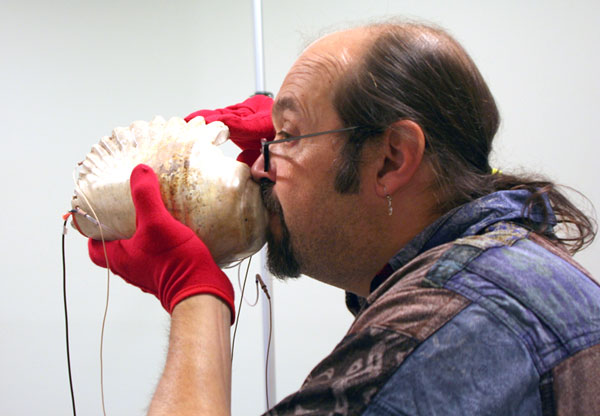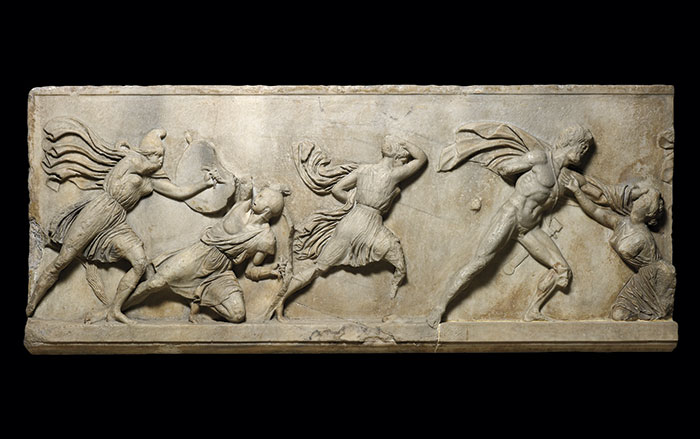
(Courtesy Jose Luis Cruzado Coronel)
The ruins of the Chavìn de Huántar temple complex in the northern Andes were once the spiritual center of a culture whose influence was felt throughout the coastal valleys of most of modern-day Peru. The 125-acre site was occupied from about 1500 to 400 B.C., during which time it extended its power and influence by spreading its religion. The priests of Chavìn became a cultural elite, perhaps the first upper class in the Peruvian Andes.
The feats of architecture at Chavìn include massive, multistory stone buildings adorned with ceramics and carvings of bone, shell, and stone, flanked by plazas 200 feet on a side. But deep inside and below the structures is something even more intriguing: a labyrinth of stone-lined corridors, shafts, galleries, and drains that have survived more or less intact and undisturbed. The maze of tunnels and small rectangular alcoves, some of which are more than 40 feet below the surface, are capable of disorienting people through tricks of sound. A team of archaeologists, anthropologists, and acoustics experts from Stanford's Center for Computer Research in Music and Acoustics (CCRMA) is trying to find out if these tunnels were deliberately designed to produce these effects.
Achieving an altered state of mind is a part of many religious ceremonies around the world, and that may have been what the priests of Chavìn were trying to create for participants in their rituals. Even before they descended into the tunnels, Chavìn's visitors and residents would have been surrounded by evidence of spiritual power and mind-altering rituals. Its buildings' facades were decorated with carvings of human and semi-human heads. Some wore grimaces or had mucus trails coming from their noses, both effects of having psychotropic snuff blown up the nostrils through a tube. Other carved heads have snakes in place of hair, while other images have the features of large cats or birds of prey, important animals in shamanistic rituals.
One carving found in a small circular plaza, most likely reserved for the elite and special ceremonies, shows a person holding a San Pedro cactus, a source of the hallucinogenic drug mescaline. Elaborately carved bone tubes, spatulas, and miniature mortars and pestles, possibly used to prepare and ingest psychotropic drugs, have also been found at the site. However, some of the strangest parts of these ancient rituals may have been the sounds that the participants heard.
Chavìn's sound effects were first noted in the 1970s by Peruvian archaeologist Luis Lumbreras, who proposed that the network of tunnels beneath the city was essentially a series of resonance rooms connected by corridors that acted as sound transmission tubes. When one visits Chavìn today, certain noises seem amplified yet difficult to pinpoint. "Any kind of sound made down there—humming, talking, or even just footsteps—creates profound resonances," says Miriam Kolar, a doctoral student with the CCRMA, who is studying the site's acoustics.

(Courtesy Jose Luis Cruzado Coronel)
While archaeologists cannot definitively say that Chavìn's tunnels were deliberately constructed to create particular acoustic effects, they do have evidence that sounds were being produced down there. In 2001, 20 decorated marine-shell trumpets called pututus were found in one of Chavìn's galleries. "These were very important instruments," says John Rick, the Stanford anthropologist who has led the excavations since 1995. They were made from a tropical species of conch that had to have been brought from at least 500 miles away. Each 10-inch shell had a mouthpiece cut into one end and an unexplained V-shaped notch cut in the outer lip. Some were so polished by use that the thick pink shells were worn through in places, suggesting decades or even centuries of handling. Significantly for the researchers, they are still playable.
In order to understand the effect these shell trumpets may have had on people listening to them, the CCRMA team decided to analyze the acoustic properties of both the shells and the labyrinth. In the case of the shells, the researchers recorded the sound of each trumpet under carefully controlled conditions, using 10 microphones, including one inside the player's mouth. With signal-processing software they captured each shell's acoustic signature in digital form. The researchers noted that the instruments have a rich overtone structure, giving them a full sound like bells or human voices. They can produce noises ranging from a wind whisper to an animal roar, and, in the hands of an expert, they can sound louder than a chainsaw from three feet away.
The next step was to take acoustic measurements of Chavìn's tunnels. The work focused on three galleries, each made up of long corridors with numerous right-angle turns and side alcoves. There were hundreds of yards of gallery spaces in all, each generally between three and six feet wide and five to 10 feet high. Test signals played on an iPod sounded through monitors set five feet high, roughly Chavìn-era head height, and dozens of receivers throughout each gallery recorded the results.
The researchers found that echoes in the galleries built extremely rapidly and from many directions simultaneously, making them diffuse and hard to locate. Tones in the same frequency range as both human voices and the shell trumpets produced consistent resonances in the alcoves, giving them an unusually rich sound, like singing in a tiled shower. Archaeologists have traditionally been slow to accept evidence that ancient people manipulated their environments to create sound effects. "Acoustics is a gray area for skeptics," Rick says. "I've been a skeptic all my life. You can't just wave your hand and say, 'I hear something strange.'" But the sound-making artifacts and, possibly, the architectural features found at Chavìn make it "extraordinarily likely," according to Rick, that some sort of sound manipulation was going on, especially when combined with the signs of ceremonial practices.
While measuring the site's acoustics is a start, interpreting the results brings up many more questions. Were these properties deliberate or a fluke of construction? Did they exist when the site was occupied, or did they change over time? Moving a wall, or using wood beams to hold up a sagging ceiling, can have a drastic effect on certain frequencies. Even if a site does have unusual acoustics, were they put to use, and if so, how? The most important and most difficult question to answer is whether the sound properties had any cultural significance.
What we can know for certain is that sound has power, and not just in a concert hall. A 2008 UCLA study found that listening to a resonant frequency of 110 hertz, in the range of a shell trumpet or a low male voice, temporarily shifted volunteers' brain activity from the logic processing left side to the emotional right side. Chavìn's religious leaders could have used unearthly noises, along with psychoactive drugs, strange lights, and images, to convince others they held the power of gods, or could become gods themselves. To take it a step further, rituals of sensory overload and coercion may have helped consolidate the priests' power as a newly minted elite.
Kolar will present results from her ongoing work later this year, but she says that patterns are definitely emerging in terms of how people perceive sound in Chavìn's underground galleries. Some architectural features seem to filter noises in certain ways, and the team is close to being able to map the way that design and construction favors certain frequencies.
Their ultimate goal is to create an acoustic model of the space, which would make it possible to digitally reconstruct the effect of any sound at any location, heard from any other. That way anyone anywhere could "hear" and experiment with Chavìn's acoustics, and they would be preserved forever. Physical conservation is a priority for archaeologists, since many of the galleries have bulging, waterlogged walls. Rick says they hope to put the original three-mile drainage system back into service starting this summer. In the meantime, they're trying to figure out whether the galleries were modified over time to enhance or preserve their acoustics, which could offer clues to whether the effects were intentional or not.
Kolar says she sometimes brings friends down into the galleries just to experience the sound of the conch trumpets for themselves. "It's always amazing what effects you get, and how that surprises people," she says. Some people report feeling ill at ease, even nauseated, as the low-frequency tones vibrate through their bodies in the dimness. Kolar has felt this herself, but also has felt "very relaxed, very mellowed out" after hours of hearing the trumpets playing. "You definitely feel like you're in a different world."











